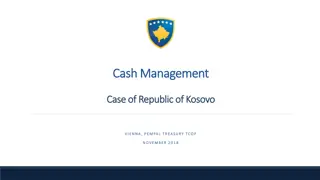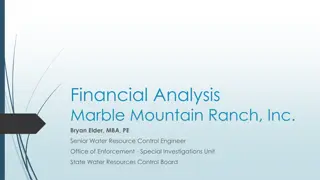Understanding Cash Management: Strategies and Techniques
Cash management involves determining the optimal amount of cash to be held at all times, balancing liquidity and profitability. This process includes motives for holding cash, techniques for controlling inflows, managing float, cash budgeting, and models for optimizing cash balance. Effective cash management aims to improve cash collections, slow down payments, and utilize strategies like concentration banking and lock box systems to streamline cash flow.
Download Presentation

Please find below an Image/Link to download the presentation.
The content on the website is provided AS IS for your information and personal use only. It may not be sold, licensed, or shared on other websites without obtaining consent from the author. Download presentation by click this link. If you encounter any issues during the download, it is possible that the publisher has removed the file from their server.
E N D
Presentation Transcript
In this session we shall cover Motives of holding cash Techniques of cash management Controlling inflows Managing float Cash budget Models to determine optimal cash balance Baumol s Model Miller-Orr Model
What is cash management? It is about determining the optimal amount to be held in form of cash at all times A balance between liquidity and profitability
Why cash management? Cash is most liquid asset and is required to make immediate payments However if kept idle, it earns no returns
Motives of holding cash Transactionary motive To meet the demand for cash arising out of day to day transactions Precautionary motive Cash to act as a buffer against unexpected events Speculative motive Cash held to take advantage of profit making opportunities Compensation motive Minimum balance of cash required to be held at all times
What shall cash management involve? Speeding up cash collections Slowing down cash payments
Controlling inflows Speeding them up Incentives can be offered to lure customers to make early / prompt payments Once cheques are received from customers there should be no delay in depositing the same with the banks Techniques by which time taken by postal intermediaries and banks can be managed and controlled, can be used Concentration banking Lock box system
Controlling inflows Speeding them up Concentration banking Firm opens collection centres / local bank accounts in different parts of the country to save postal delays Customers are instructed to mail their payments to such regional collection centres Lock box system A box is installed by the firm at various local post offices The customers are then asked to drop their payments in nearby lock boxes The firm arranges with a local bank or some other agency to collect payments from such boxes frequently and credit to firm s account at the earliest
Managing float It is a mechanism to reduce the length of cash cycle When a firm receives / makes payment through cheques, there is usually a time gap between the time the cheque is written and when the cheque is cleared This time gap is referred to as FLOAT Float for the paying firm: Time between issue of cheque and funds actually getting debited from the bank account Float for the payee firm: Time gap between receipt of cheque and funds actually getting credited in bank account
Managing float 3 components of float: Mail time Time gap between issue of cheque and receipt of cheque Processing time Time gap between receipt of cheque and deposit of same in the bank account Collection time Amount of time for transferring funds taken by the banking system
Managing float Payment float: Amount of cheques issued but not presented for payment Receipt float: Amount of cheques deposited in bank but not yet cleared Net float = Payment float Receipt float Positive net float Negative net float
Cash budget It is an estimate of cash inflows and cash outflows for a specified time in future Helps in determination of cash requirements
Example Cash budget The following information is given: January February March April Sales 75,000 1,05,000 1,80,000 1,05,000 Raw material 70,000 1,00,000 80,000 85,000 Manufacturing expenses 10,000 20,000 29,000 16,000 Loan installment 1,000 11,000 21,000 21,000
Example Cash budget Additional information: 1. All sales are made on credit basis. 2/3rdof debtors are collected in the same month and the balance in the next month. The debtors on 1stJan were Rs 30,000. There are no expected bad debts. 2. The minimum cash balance must be Rs 5,000. However the cash balance on 1stJan was Rs 6,500. 3. Borrowing can be made in multiples of Rs 100 only. Prepare Cash Budget for 4 months.
Calculation of cash collections from sales January February March April Sales 75,000 1,05,000 1,80,000 1,05,000 All sales are made on credit basis. 2/3rd of debtors are collected in the same month and the balance in the next month. The debtors on 1st Jan were Rs 30,000. There are no expected bad debts.
Calculation of cash collections from sales Collection from debtors January February March April Of previous month (1/3) 30,000 25,000 35,000 60,000 Of current month (2/3) 50,000 70,000 1,20,000 70,000
Cash budget January Opening balance 6500
Cash budget January Opening balance 6500 Cash inflows: Collection from sales Of previous month (1/3) 30,000 Of current month (2/3) 50,000
Cash budget January Opening balance 6500 Cash inflows: Collection from sales Of previous month (1/3) 30,000 Of current month (2/3) 50,000 Cash outflows: Raw material (70,000) Manufacturing expenses (10,000) Loan instalment (1,000)
Cash budget January Opening balance 6500 Cash inflows: Collection from sales Of previous month (1/3) 30,000 Of current month (2/3) 50,000 Cash outflows: Raw material (70,000) Manufacturing expenses (10,000) Loan instalment (1,000) NET CASH BALANCE 5500 Borrowing / Repayment - Closing balance 5500
Cash budget January February Opening balance 6500 5500 Cash inflows: Collection from sales Of previous month (1/3) 30,000 Of current month (2/3) 50,000 Cash outflows: Raw material (70,000) Manufacturing expenses (10,000) Loan instalment (1,000) NET CASH BALANCE 5500 Borrowing / Repayment - Closing balance 5500
Cash budget January February Opening balance 6500 5500 Cash inflows: Collection from sales Of previous month (1/3) 30,000 25,000 Of current month (2/3) 50,000 70,000 Cash outflows: Raw material (70,000) (1,00,000) Manufacturing expenses (10,000) (20,000) Loan instalment (1,000) (11,000) NET CASH BALANCE 5500 (30500) Borrowing / Repayment - 35500 Closing balance 5500 5000
Cash budget January February March Opening balance 6500 5500 5000 Cash inflows: Collection from sales Of previous month (1/3) 30,000 25,000 Of current month (2/3) 50,000 70,000 Cash outflows: Raw material (70,000) (1,00,000) Manufacturing expenses (10,000) (20,000) Loan instalment (1,000) (11,000) NET CASH BALANCE 5500 (30500) Borrowing / Repayment - 35500 Closing balance 5500 5000
Cash budget January February March Opening balance 6500 5500 5000 Cash inflows: Collection from sales Of previous month (1/3) 30,000 25,000 35,000 Of current month (2/3) 50,000 70,000 1,20,000 Cash outflows: Raw material (70,000) (1,00,000) (80,000) Manufacturing expenses (10,000) (20,000) (29,000) Loan instalment (1,000) (11,000) (21,000) NET CASH BALANCE 5500 (30500) 30000 Borrowing / Repayment - 35500 (25000) Closing balance 5500 5000 5000
Cash budget January February March April Opening balance 6500 5500 5000 5000 Cash inflows: Collection from sales Of previous month (1/3) 30,000 25,000 35,000 Of current month (2/3) 50,000 70,000 1,20,000 Cash outflows: Raw material (70,000) (1,00,000) (80,000) Manufacturing expenses (10,000) (20,000) (29,000) Loan instalment (1,000) (11,000) (21,000) NET CASH BALANCE 5500 (30500) 30000 Borrowing / Repayment - 35500 (25000) Closing balance 5500 5000 5000
Cash budget January February March April Opening balance 6500 5500 5000 5000 Cash inflows: Collection from sales Of previous month (1/3) 30,000 25,000 35,000 60,000 Of current month (2/3) 50,000 70,000 1,20,000 70,000 Cash outflows: Raw material (70,000) (1,00,000) (80,000) (85,000) Manufacturing expenses (10,000) (20,000) (29,000) (16,000) Loan instalment (1,000) (11,000) (21,000) (21,000) NET CASH BALANCE 5500 (30500) 30000 13000 Borrowing / Repayment - 35500 (25000) (8000) Closing balance 5500 5000 5000 5000
Models of determining Optimal Cash Balance Baumol s Model Miller Orr Model
Baumols Model It aims to balance the income foregone on cash held by the firm against the transaction cost of converting cash into marketable securities or vice-versa Striking a balance between 2 costs: Holding cost Transaction cost
Baumols Model Holding cost can be reduced by keeping least amount as cash in hand Optimal cash balance is that level at which the holding cost and transaction cost is controlled so as to minimize the total cost As cash depletes, a transaction cost to be paid on converting securities into cash would increase
Baumols Model To arrive at the optimal cash balance C = 2FT/r Where, C: cash required each time to restore balance to minimum cash balance F: total cash required during the year T : cost of each transaction between cash and marketable securities r: rate of interest on marketable securities
Example A firm has a total cash requirement of Rs 5,00,000 p.a. The rate of interest is 15% and every time it has to pay Rs 25 to enter into a transaction of marketable securities. What is the optimal cash balance under Baumol s Model?
Example C = 2FT/r = (2*5,00,000*25) / 0.15 = Rs 12,910
Miller Orr Model Miller Orr argues that changes in cash balance over a given period of time are random in size as well as direction The model specifies two control limits: Upper limit (H): beyond which cash balance need not be allowed to go Lower limit (L): below which cash balance is not allowed to reduce
Miller Orr Model If the cash balance reaches the UPPER CONTROL LIMIT, then cash should be converted into marketable securities in a manner that cash balance comes down to a pre-determined level RETURN LEVEL
Miller Orr Model RETURN LEVEL If the cash balance reaches the LOWER CONTROL LIMIT, then sufficient marketable securities should be sold to realise cash so that the cash balance is restored back to R level
Calculation of different cash levels under Miller-Orr Model Z = 3 3TV 4i Here, T: transaction cost of conversion V: variance of daily cash flows i: daily % Interest rate on investments R = L + Z H = 3Z + L
Example If a firm has standard deviation of Rs 1200 in the daily cash flows, the daily i% = 0.01% and T = Rs 20 and the minimum level required is Rs 1000. Calculate Z, R and H.
Example Z = 3 3*20*14,40,000 4*0.0001 = 6000
Example Z = 3 3*20*14,40,000 4*0.0001 = 6000 R = L + Z = 1000 + 6000 = 7000
Example Z = 3 3*20*14,40,000 4*0.0001 = 6000 R = L + Z = 1000 + 6000 = 7000 H = 3Z + L = (3*6000) + 1000 = 19000
To summarise Cash management is about determining the optimal amount to be held in form of cash at all times, striking a balance between liquidity and profitability There are different motives of firm holding cash transactionary, precautionary, speculative and compensation motive Various techniques can be adopted to accelerate the cash inflows and slow down the cash outflows for a business firm Managing float Cash budget Concentration banking Lock box system There are different models to determine optimal cash level Baumol s model Miller-Orr model























